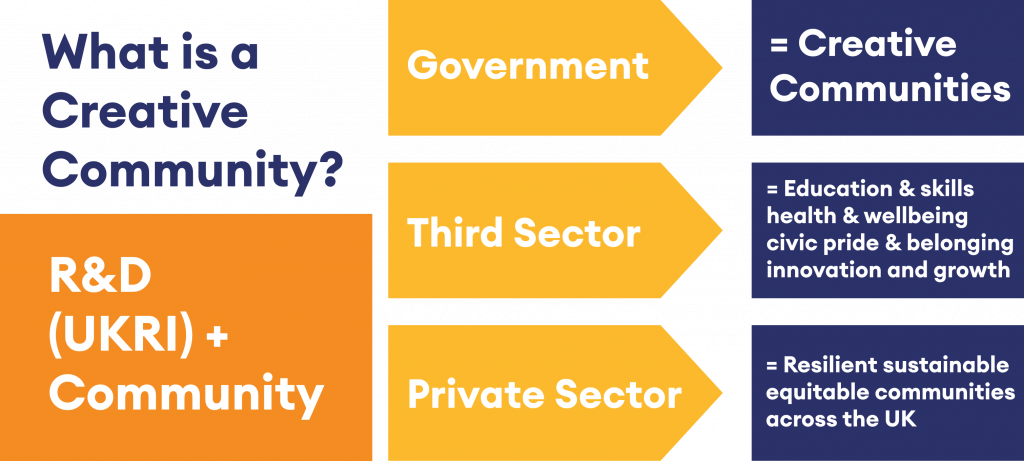
A creative community describes collaborative cross-sector R&D that brings together diverse actors from community, government, education, arms length, third and private sector organisations in a place-based consortia that delivers new culture, creates added value and generates economic, social and cultural spill overs for research partners and wider society. As a delivery mechanism for R&D, Creative Communities are characterised by the involvement of a diverse range of stakeholders and sectors. Together they work to build a cooperation network of exchange, spreading models of partnership working into other professional environments. Creative Communities can involve a combination of:

This formula frames an indicative example of partners in a creative community, but the specific types of activity within these formulas are diverse and fluid in practice. By placing communities at the heart of the design, implementation and evaluation of culture, the Creative Community model facilitates an adaptive and flexible framework within which public, private and civil society organisations can participate together.. The delivery model focuses on the ways in which engaging communities and third and private sector partners in the entirety of the research cycle can bring new skills, experience, knowledge and networks to R&D and maximise our resource by working more closely together around shared challenges.
The key enabling features of Creative Communities include:
The objectives of Creative Communities can be radical innovations or the exploitation of niche areas, optimising access to and use of resources, or strengthening innovation in the regions through the hyper-local. They often occur around place-based assets like a community centre, heritage or arts site and enable new social, cultural and economic networks around that asset between local industries and organisations that share similar interests.

Drives for Creative Community formation include shared challenges, funding opportunities, identified problems and sometimes moments of crisis. Many Creative Communities use anentrepreneurial discovery approach with wider stakeholders to draw in other actors with a shared interest in these challenge zones, adopting an outward looking methodology that embraces a broad understanding of partnership working and communities to be inclusive of all stakeholder involvement.
The Creative Community model directly addresses the UKRI strategic aim to work as a funder across an expanded research ecosystem, with communities as researchers rather than just the subjects of research. The consortia model builds enhanced resilience, mitigates risk, promotes knowledge exchange and transfer and supercharges the capacity of communities to attract inward and outward investment into their cultural ecosystem. But there is no one size fits all model. Creative Communities vary in levels of expertise, forms of engagement, location, depth of partnership and purpose. The density of Creative Communities varies region to region, as well as nation by nation. Distinct communities have specific needs and there are a variety of delivery models for the Creative Communities research featured in our deep dive report.

Creative Communities are concerned with process as much as output. In this model success can not only be measured by the production of an underpinning journal article or research output or a single research activity but can also be expressed through the creation of a wider ecosystem of knowledge or a culture shift in ways of working. The creation of new knowledge, networks, products, jobs, skills, businesses and civic partnerships are equally valid measures of success for Creative Communities. The policy potential of the model lies in its capacity building around culture and R&D in a place, creating connectivity and communication between partners and establishing the networks necessary for responsive bids to funding opportunities, effective understanding of assets and data, and a reduced reliance on external consultants to represent a place and its people.
Linking research and innovation actors with industrial stakeholders, Creative Communities help to exploit complementarities in the development of new knowledge and by bringing together diverse partners they promote access to knowledge sources and empower communities to create new resources and redeploy existing ones. By sharing knowledge, resources and networks, Creative Communities create the capacity to make long-term change and generate new solutions to some of the most pressing issues facing our society today. Their engagement and support in partnership R&D is based on effective communication and shared responsibility for the design and the delivery of the programme of work, as well as for generating understanding of the change it makes both for the partners involved and for wider society.
Brought to you by


